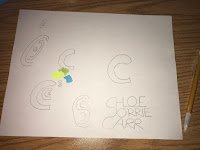Chloe Carr
Module #2
1. The first video was very interesting to watch. The basics of what I've learned is that the philosophical study of beauty and art is called aesthtics. The philosophy of art is what art is; what makes something a work of art. Through the philosophy of art we can decipher between whether or not something is a work of art. The video went on to explain how art was potrayed in the 5th century, and especially what important people contributed to the idea and definition of art. Some of these people included Plato, Aristotle, Aleberti, Addison, Shaftburry, and Baumgarten. Something I learned that I found extremely interesting is Aristotle's idea of the forms of beauty. He believed that the forms of beauty were made up of three things: order, symmetry, and defiteness. Like Aristotle, Alberti believed that beauty was harmony and that there were principles of formal order or neoclastical aesthetics, which were proportion, symmetry, harmony, and order. This video expanded a lot about what aesthetics meant to each of the philosophers mentioned.
The second video focused more on what a work of art is and what aesthetics meant
for art. Jean-Pierre Changeux described works of art as, "human productions specialized for intersubjective communications" that uses symbolic forms. This to me means that art is something made by people to be understood by the minds of other people. He believes that art is something outside of verbal language.
2. After the 18th century in England where there formed a foundation for aesthetics, Shaftsburry also came to be of influence. I find his theory on aesthetics to be very important because it's closest to what I want to believe about aesthetics. Shaftsburry said there was no true aesthetic delight that did not include good, or any true, moral pleasure that did not include beauty. Basically he meant that beauty and good are the same thing. He also said that there is a certain harmony to art as harmony is a sign of divine order. To Shaftsburry, any work of art that has beauty and harmony is taken through our senses so that we can actually
see the beauty. It's strictly for the mind. He contributed so much so to the idea of aesthetics that other philosophers, especially Francis Hutcherson, spent most of their career building onto his belief.
3. Though Changeux spoke a lot about works of art and how something can become a work of art, he also spoke about aesthetics. During his lecture, he defined aesthetics as the, "staggering affects on emotion and reason mobilising conscious and non-conscious processes." In saying this, he's saying that the effect a work of art has on a person can be defined as the aesthetics of that work of art, whether that emotional effect be conscious or non-conscious. He showed examples by showing the human skull and the change over time. He showed the symmetry of the skull and space of the brain inside of it.
Ramachandran talked more about neurological theory of art and came up wih the science of art, which I found pretty interesting. He believes that art is about asserting human individuality and science is about discovering universal principles. Ramachandran argued that unlike the belief that art and science should never meet as they are opposites, they will always meet when it comes to the brain. He first noticed the relationship when he became fascinated by art from a place he had been visiting. The effects of the art were so powerful that he started thinking about them very often, which lead him to believe that there was an effect of art and its meaning on the human mind. His talk elaborates on that discovery and the history of the reactions of people brought on by art which should not always be realostic. I liked that he was able to find an
unrealistic approach to art while also using science to explain why art means so much to people.
4. Like the videos, the readings in the text also focus on the history of art. The book defines aesthetics as the, "branch of philosophy concerned with feeling aroused in us by sensory experiences. This means that there is a relationship between art and our five senses. It also goes indepth about the history of art and the meaning it serves and has served for centuries. The book gives examples like the carvings in Chauvet Cave to explain that art has been around since the Paleolithic era. The article we had to read says that we recognize art and recognize that images we see can be clear representations of things or places or people we see in our everyday life. The book, not unlike the article, says that some images we see may not be art, "but our ability to make them is one place where art begins." Both the article and the book can relate to the videos because the videos expand on the relationship between art and humans. Ultimately, we are able to find beauty and art in images that we see because of how our brains work and how they are wired. We are able to find meaning in even the most unrealistic kinds of art.
5. The films and article helped me better understand the reading in the text by expanding more behind the background. The book gives examples of what the films and article were saying. For example, the article explained how lines were an important aspect of art. Line drawings, according to the article, date back to centuries ago during the time of our great ancestors. I would not have thought much about that fact until I saw the cave drawings outlined by lines in the textbook. I never thought about the fact that outlines in drawings serve such a heavy meaning.










